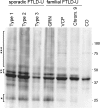TDP-43 in familial and sporadic frontotemporal lobar degeneration with ubiquitin inclusions
- PMID: 17591968
- PMCID: PMC1941578
- DOI: 10.2353/ajpath.2007.070182
TDP-43 in familial and sporadic frontotemporal lobar degeneration with ubiquitin inclusions
Abstract
TAR DNA-binding protein 43 (TDP-43) is a major pathological protein of sporadic and familial frontotemporal lobar degeneration with ubiquitin-positive, tau-negative inclusions (FTLD-U) with or without motor neuron disease (MND). Thus, TDP-43 defines a novel class of neurodegenerative diseases called TDP-43 proteinopathies. We performed ubiquitin and TDP-43 immunohistochemistry on 193 cases of familial and sporadic FTLD with or without MND. On selected cases, immunoelectron microscopy and biochemistry were performed. Clinically defined frontotemporal dementias (FTDs) included four groups: 1) familial FTD with mutations in progranulin (n = 36), valosin-containing protein (n = 5), charged multivesicular body protein 2B (n = 4), and linked to chromosome 9p (n = 7); 2) familial cases of FTD with unknown gene association (n = 29); 3) sporadic FTD (n = 72); and 4) familial and sporadic FTD with MND (n = 40). Our studies confirm that the spectrum of TDP-43 proteinopathies includes most cases of sporadic and familial FTLD-U with and without MND and expand this disease spectrum to include reported families with FTD linked to chromosome 9p but not FTD with charged multivesicular body protein 2B mutations. Thus, despite significant clinical, genetic, and neuropathological heterogeneity of FTLD-U, TDP-43 is a common pathological substrate underlying a large subset of these disorders, thereby implicating TDP-43 in novel and unifying mechanisms of FTLD pathogenesis.
Figures





References
-
- Neary D, Snowden JS, Mann DM. Classification and description of frontotemporal dementias. Ann NY Acad Sci. 2000;920:46–51. - PubMed
-
- Lipton AM, White CL, III, Bigio EH. Frontotemporal lobar degeneration with motor neuron disease-type inclusions predominates in 76 cases of frontotemporal degeneration. Acta Neuropathol (Berl) 2004;108:379–385. - PubMed
Publication types
MeSH terms
Substances
Grants and funding
- P30 AG013854/AG/NIA NIH HHS/United States
- P30 AG010124/AG/NIA NIH HHS/United States
- AG10124/AG/NIA NIH HHS/United States
- P01 AG017586/AG/NIA NIH HHS/United States
- AG12300/AG/NIA NIH HHS/United States
- AG03991/AG/NIA NIH HHS/United States
- U01 AG016976/AG/NIA NIH HHS/United States
- P01 AG003991/AG/NIA NIH HHS/United States
- P50 AG005681/AG/NIA NIH HHS/United States
- P30 AG012300/AG/NIA NIH HHS/United States
- AG05681/AG/NIA NIH HHS/United States
- AG17586/AG/NIA NIH HHS/United States
- AG16976/AG/NIA NIH HHS/United States
- AG13854/AG/NIA NIH HHS/United States
LinkOut - more resources
Full Text Sources
Other Literature Sources
Medical

